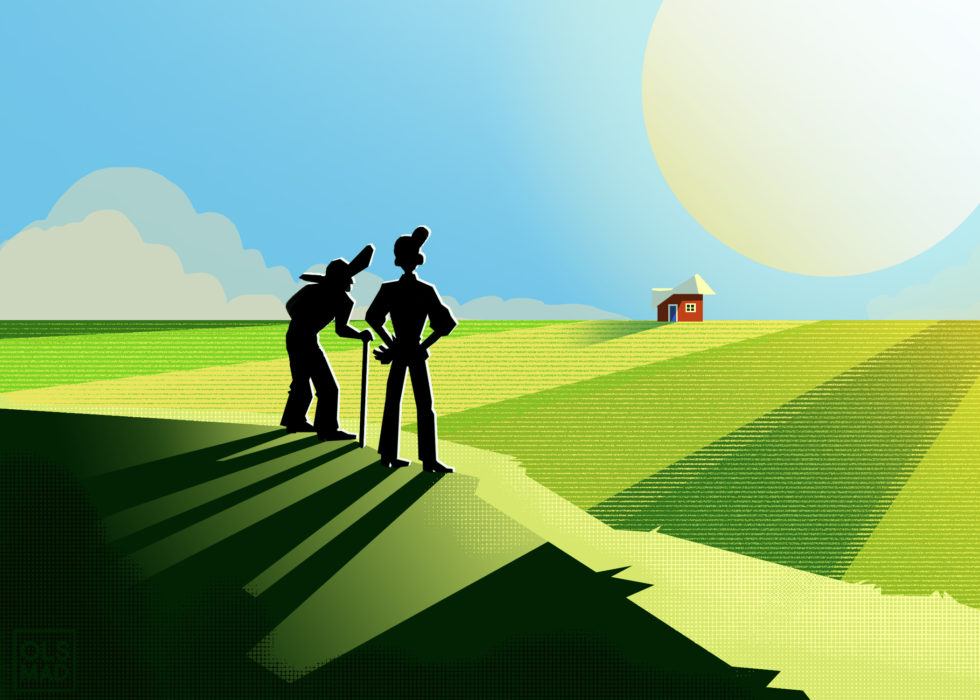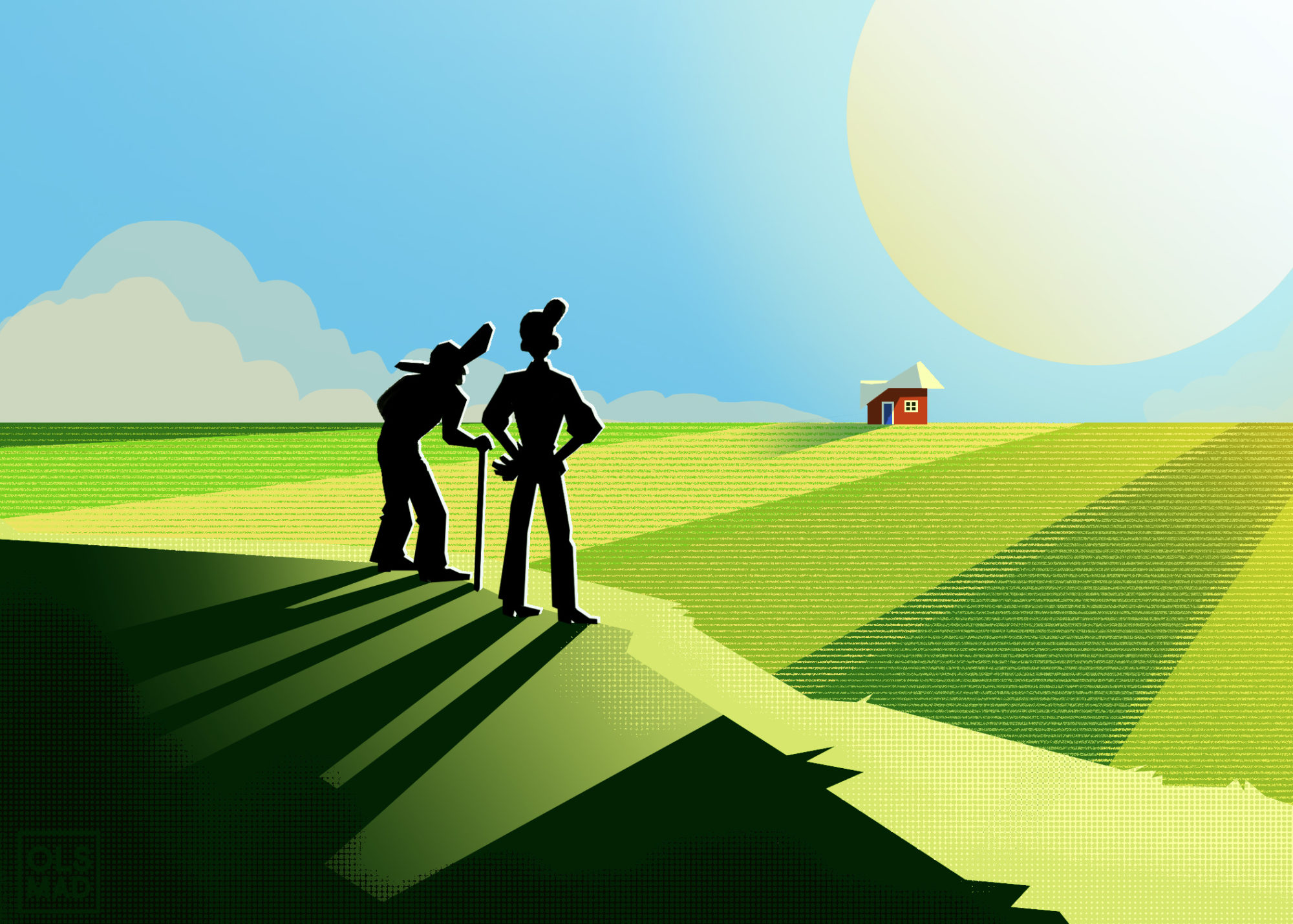
Though the drive through Helmville, Montana, takes little more than 20 seconds, the Blackfoot Valley town has everything it needs: a school, post office, two churches, a graveyard, and a bar. Katie Geary runs the latter, the Copper Queen Saloon, where she serves the community she grew up in, across Highway 271 from land her family has been ranching since 1867. When she’s not pouring beers, Geary spends her days caring for her three young children and helping her brother and husband ranch.
From the saloon to weather to water to commodity prices to endangered species, there’s a lot on the mind of a Geary. Perhaps the hardest discussions her family has, though, are the ones about how the ranch will be passed down to the next generation.
Despite its importance, succession planning tends to end up at the bottom of the priority list for farmers and ranchers — little surprise given the daily challenges they tackle. But Geary is one young rancher that’s starting the conversation early. “Why wait until you’ve passed,” she said, “to have people try to determine what your wishes were?” In doing so, she’s not just heeding the advice of succession experts, but taking a step critical to maintaining the West’s agricultural land.
According to the American Farmland Trust, 40 percent of farms and ranches will change hands over the next 15 years. Between 1992 and 2012, a Trust study found, 62 percent of all land converted to housing, offices, strip malls and the like in the United States was prime agricultural land. All told, 31 million acres of farmland was developed — an area the size of New York state.
Keeping land in agricultural use serves many purposes. In addition to food production, ranches and farms serve as corridors for wildlife and the economic backbone of many rural communities. Without firm succession plans, though, ag land is more likely to end up as tract housing, strip malls, or a billionaire’s vacation retreat when a landowner dies or chooses to sell.
The first step in succession planning is starting the conversation.
“Dealing with reluctance to talk about the end of the line is very difficult,” said Jerry Cosgrove, the farm legacy director at American Farmland Trust.
Increasingly, though, there are people that can help farmers and ranchers do this very thing. Dick Wittman has been a succession consultant in northern Idaho for 40 years. “To do this job, you’ve got to have about 10 [college] degrees. And it helps to be a management expert, psychologist, finance guru, and maybe a priest,” he said. “But being a facilitator is the key.”
When Wittman sits down with a farming family, the first thing he does is help them clearly define their mission, vision, core values, job descriptions, and policies. This helps farmers see their operations as a business and not just a way of life. “There’s an elite, small percentage of ag that gets this,” he said. “Those that get this are planning ahead and having engaged discussions with their heirs.”
These discussions cover everything from how the shares of the farm will be handed down to who will live in what house on the property. Everyone needs clearly defined roles — and mutual respect for how those roles are delegated.
The Blackfoot Valley has some of the longest-ranching families in Montana, and passing the land down through the generations can be complicated and emotional on a social, economic, and legal level.
In Geary’s family, succession was seldom discussed. As with many ranches, Geary Ranch shares are passed down upon the death of a shareholder as dictated in his or her will. The amount of shares a family member receives typically depends on the number of siblings, and may or may not reflect the level of commitment they have to the ranch. The ranch’s business decisions are made by five board members, elected by shareholders. Those who are most committed to working the ranch, like Katie and her brother, Jacob, might not have a say in what happens to the ranch as it is passed down, especially in a large family where there are many shareholders.
Younger ranchers might not know the status of their shares until a parent has died. But Geary is trying to encourage her generation to be more open about the succession of the ranch, which she said comes from watching her parents’ generation struggle to determine what the deceased person’s wishes were, which can lead to division within the family.
“During the mourning and grieving process, you’re also worrying about how to split things up,” Geary said. “Whereas if these things had been talked about before [death], I don’t think there would be as many hard feelings, because you have to honor that person’s wishes while they are alive.”
For another Helmville ranching family, these conversations do begin early. When 34-year-old Logan Mannix was in high school, the family began including him in their twice-yearly conversations about succession. His parents wanted to understand their children’s desire — or lack thereof — to come back to the ranch, and to help determine what kind of education the kids should pursue to best help the ranch.
“From an early age they began communicating things like, We want to be fair, but it’s not necessarily always equal,” Mannix said. Having these conversations early and often took the edge off, he said, and younger family members understood how the process works and why it’s so hard to divvy up shares.
Mannix hopes to spend his entire career on the ranch, working alongside his father, brothers, and uncles. Similar to the Geary Ranch, the Mannix Ranch is governed by a board of family members. That means when succession happens, shares might be divided evenly among successors, but the decision-making power still remains concentrated in the hands of the board, whose members typically have a greater commitment to and presence on the ranch.
The Mannix family has found mediators useful in the harder discussions. With a family business, small affairs can quickly become big issues, and Mannix said it helps to have a professional mediator without years of family history coloring how statements are judged. Montana, like most states in the West, offers state-funded mediation programs certified through the U.S. Department of Agriculture.
Ag operations without a family heir face other succession hurdles. According to the National Young Farmers Coalition, two-thirds of U.S. farms will need a new farmer in the next couple decades. For those who don’t have heirs, or whose heirs do not want to take over the business, their wish is most often to see the land remain in production. There is demand — 75 percent of people entering agriculture and younger than 40 did not grow up with a farming background, according to the coalition’s data — but an individual farmer can’t match the deep pockets of a real estate investor or corporate agriculture firm.
“It’s not going to work to keep going like this, where land is not valued for ag use,” said Holly Rippon-Butler, the land access program manager for the National Young Farmers Coalition. “If we don’t prioritize and make sure this generation can get on the land and get the security they need, and for the older generation to retire, it can dramatically change the next generation on the landscapes.” The NYFC guides up-and-coming farmers in finding land and beginning a business, part of which means connecting them with landowners looking to retire.
For the Mannix family, relationships between family members and outside partners have been key to the survival of the ranch. Those open, tolerant, and trusting bonds were seeded early on, and have been passed down through the generations.
“Those relationships tend to breed hope,” said Logan’s father, David Mannix. The open lines of communication also breed a willingness to try new things instead of plowing the same old ruts, which keeps the younger generations on the land.
“If the answer is always no, it’s hard to come back,” said David. “But if we’re able to take care of a resource, that’s a big reward that comes back to you economically, socially and also spiritually.”

